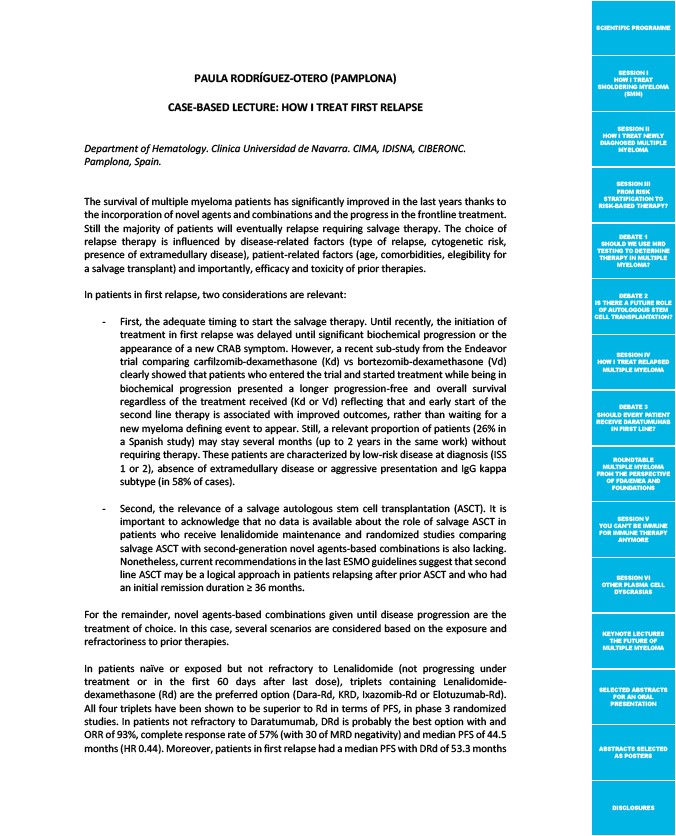
SCIENTIFIC PROGRAMME
SESSION I
HOW I TREAT
SMOLDERING MYELOMA
(SMM)
SESSION II
HOW I TREAT NEWLY
DIAGNOSED MULTIPLE
MYELOMA
SESSION III
FROM RISK
STRATIFICATION TO
RISK-BASED THERAPY?
DEBATE 1
SHOULD WE USE MRD
TESTING TO DETERMINE
THERAPY IN MULTIPLE
MYELOMA?
DEBATE 2
IS THERE A FUTURE ROLE
OF AUTOLOGOUS STEM
CELL TRANSPLANTATION?
SESSION IV
HOW I TREAT RELAPSED
MULTIPLE MYELOMA
DEBATE 3
SHOULD EVERY PATIENT
RECEIVE DARATUMUMAB
IN FIRST LINE?
ROUNDTABLE
MULTIPLE MYELOMA
FROM THE PERSPECTIVE
OF FDA/EMEA AND
FOUNDATIONS
SESSION V
YOU CAN’T BE IMMUNE
FOR IMMUNE THERAPY
ANYMORE
SESSION VI
OTHER PLASMA CELL
DYSCRASIAS
KEYNOTE LECTURES
THE FUTURE OF
MULTIPLE MYELOMA
SELECTED ABSTRACTS
FOR AN ORAL
PRESENTATION
ABSTRACTS SELECTED
AS POSTERS
DISCLOSURES
PAULA RODRÍGUEZ-OTERO (PAMPLONA)
CASE-BASED LECTURE: HOW I TREAT FIRST RELAPSE
Department of Hematology. Clinica Universidad de Navarra. CIMA, IDISNA, CIBERONC.
Pamplona, Spain.
The survival of multiple myeloma patients has significantly improved in the last years thanks to
the incorporation of novel agents and combinations and the progress in the frontline treatment.
Still the majority of patients will eventually relapse requiring salvage therapy. The choice of
relapse therapy is influenced by disease-related factors (type of relapse, cytogenetic risk,
presence of extramedullary disease), patient-related factors (age, comorbidities, elegibility for
a salvage transplant) and importantly, efficacy and toxicity of prior therapies.
In patients in first relapse, two considerations are relevant:
- First, the adequate timing to start the salvage therapy. Until recently, the initiation of
treatment in first relapse was delayed until significant biochemical progression or the
appearance of a new CRAB symptom. However, a recent sub-study from the Endeavor
trial comparing carfilzomib-dexamethasone (Kd) vs bortezomib-dexamethasone (Vd)
clearly showed that patients who entered the trial and started treatment while being in
biochemical progression presented a longer progression-free and overall survival
regardless of the treatment received (Kd or Vd) reflecting that and early start of the
second line therapy is associated with improved outcomes, rather than waiting for a
new myeloma defining event to appear. Still, a relevant proportion of patients (26% in
a Spanish study) may stay several months (up to 2 years in the same work) without
requiring therapy. These patients are characterized by low-risk disease at diagnosis (ISS
1 or 2), absence of extramedullary disease or aggressive presentation and IgG kappa
subtype (in 58% of cases).
- Second, the relevance of a salvage autologous stem cell transplantation (ASCT). It is
important to acknowledge that no data is available about the role of salvage ASCT in
patients who receive lenalidomide maintenance and randomized studies comparing
salvage ASCT with second-generation novel agents-based combinations is also lacking.
Nonetheless, current recommendations in the last ESMO guidelines suggest that second
line ASCT may be a logical approach in patients relapsing after prior ASCT and who had
an initial remission duration ≥ 36 months.
For the remainder, novel agents-based combinations given until disease progression are the
treatment of choice. In this case, several scenarios are considered based on the exposure and
refractoriness to prior therapies.
In patients naïve or exposed but not refractory to Lenalidomide (not progressing under
treatment or in the first 60 days after last dose), triplets containing Lenalidomide-dexamethasone
(Rd) are the preferred option (Dara-Rd, KRD, Ixazomib-Rd or Elotuzumab-Rd).
All four triplets have been shown to be superior to Rd in terms of PFS, in phase 3 randomized
studies. In patients not refractory to Daratumumab, DRd is probably the best option with and
ORR of 93%, complete response rate of 57% (with 30 of MRD negativity) and median PFS of 44.5
months (HR 0.44). Moreover, patients in first relapse had a median PFS with DRd of 53.3 months